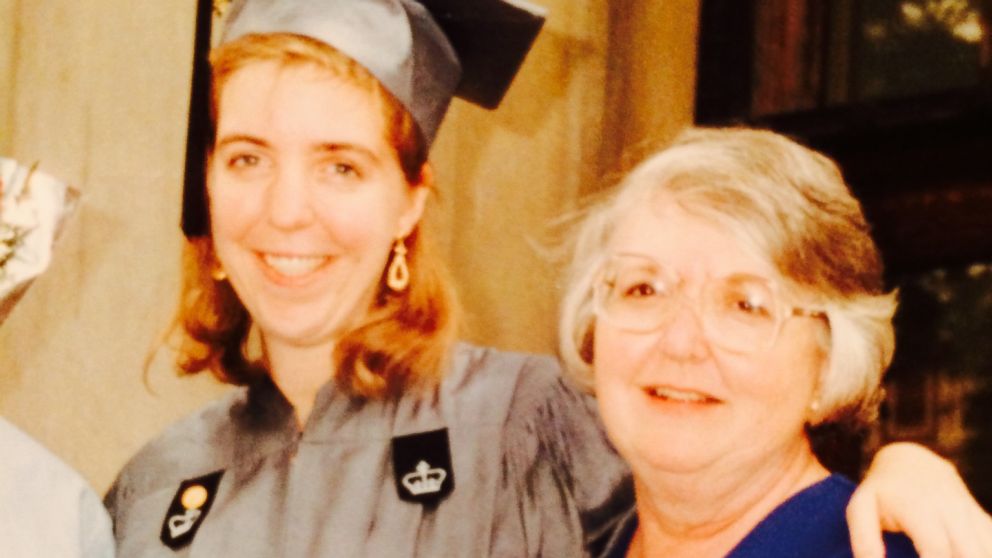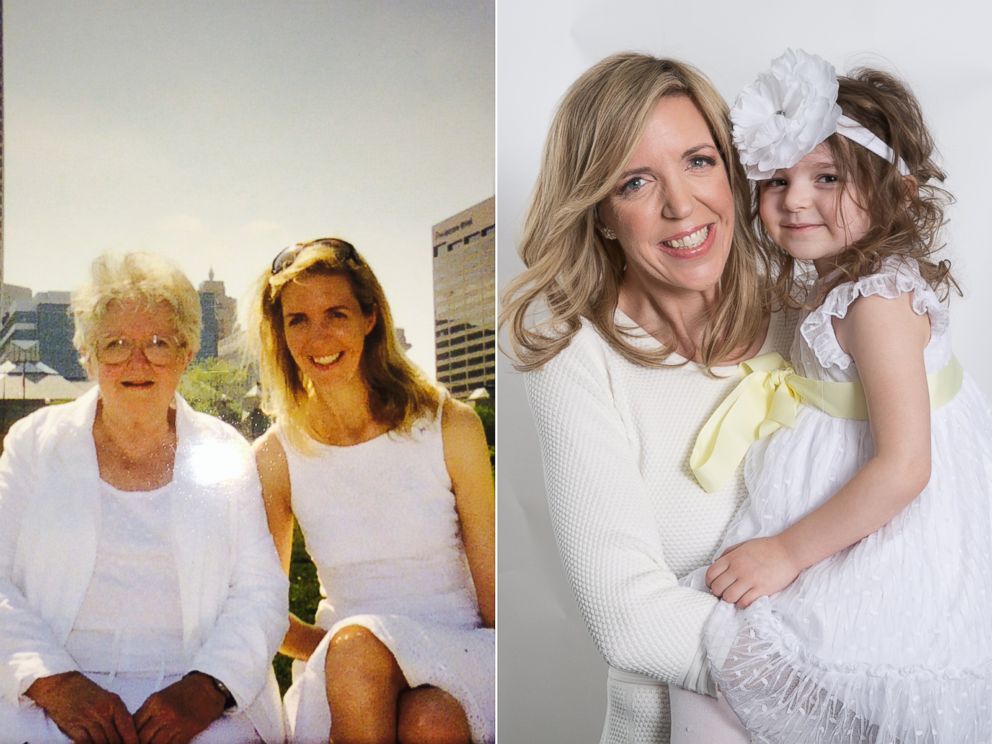Confessions From the Daughter of a Compulsive Hoarder
A "GMA" producer recounts her journey to rescue her mother from hoarding.

— -- "Good Morning America" producer Mary Pflum Peterson grew up with a mother who gave her everything. Everything, that is, except a clean house. That's because her mother was a secret hoarder. Pflum Peterson recounts her journey to rescue her mother, a former nun, from her own compulsion, in her book, "White Dresses," and shares what it's really like to grow up as the child of a hoarder in a personal essay below.
Read an Excerpt: 'White Dresses: A Memoir of Love and Secrets, Mothers and Daughters'
Here’s a confession: I don’t like "Throwback Thursdays." In fact, I dread them. It's not that I don't like social media. On the contrary, I'm a fan. As a seasoned "Good Morning America" producer, I enjoy posting about my latest assignments -- whether it's a trip to London to cover the birth of a royal baby or a great big makeover, featuring a series of dramatically different "before" and "after" photos. And as a mom of four, I enjoy putting together montages and Facebook photo albums featuring the adventures of my kids. But "Throwback Thursdays" - that day of the week in which Facebook and Instagram devotees post pictures of their youth, ranging from baby pictures to first-day-of-school-pictures to yellowed prom pics–are something I just can’t do. The day more often than not leaves me feeling blue because –- here’s another confession -- I don’t have photos to throw back to.
Most of my childhood photos were destroyed. Not in a flood or house fire. Not in the sort of hurricanes I've routinely covered for "GMA." No, my childhood photos were destroyed by a house of hoarding. My mother, you see, was a compulsive hoarder.
When you hear the word "hoarding," I know what most of you are thinking. You’re thinking about those images of hoarding depicted on reality shows. Maybe you’re envisioning a backwoods trailer piled high with debris. But that’s not how hoarding was for me –- or is for so many children of hoarders. I grew up in a nice house on a nice street. I wore nice clothes to school and church. Our family was well educated and well-spoken and as a group we were active in the community.
My mother worked –- and was a decorated and beloved teacher. My brother and I did exceptionally well in school, excelling both academically and in a spate of extracurricular activities. And my mother was energetic and loving. So loving. No day began or ended without a declaration of "I love you." All was relatively normal. All but that great big secret of a great big mess my mother hid behind our closed doors.

My mother's hoarding started when I was a small child in the 1980s, shortly after my father left. Back then, there wasn't a word for hoarding the way there is now. It wasn't something people talked about. I only knew something was wrong. Very wrong.
It started with the mail. My mother never opened it. She stacked it up in the living room. One pile of unopened envelopes and catalogs and magazines became two, then three, then a dozen. Next came the newspapers. She read four a day, sometimes more, but refused to throw any of them away. Then there were the appliances. When the dishwasher broke, it wasn't replaced. It just sat. Same thing happened with the gigantic Lipton microwave that took up an entire counter top. Then the television sets. By the time I was 12, the house was taking on the look and feel of a used appliance museum. Everything was broken. Just like much of my poor mother's spirit.
By the time I graduated from high school, my future, to the outside world, seemed bright. I graduated at the top of my class, won a host of scholarships. But my top grades were dampened by my house, which I could barely walk through, depending on the day of the week.

By the time I was in my mid-20s and my career in TV news started to take off, the house was essentially lost to the piles and piles of stuff. The piles swallowed entire pieces of furniture whole, turned entire staircases into enormous fabric slopes, covered with old clothes and linen. In the process, precious belongings were destroyed. Among the carnage -- beloved dolls and stuffed animals, cherished awards -- including certificates and ribbons and medals and trophies related to me being named class Valedictorian, the recipient of the John Philip Sousa Award, the school’s Science Fair champion. And, of course, my photos.
So many images of me as an infant, a toddler, a Brownie, a birthday girl, were destroyed in the heaps of stuff -- victims of dust, dirt, grime, mold and, worse, moths and mice. I managed to take a few photos with me when I went to college. But most, including all of my old yearbooks, I’d left at home, hopeful I’d reclaim them when I got married, or when I managed to help my mother fix up the house once and for all. I’d tried to for years to help her clean things up as a child. But there’s only so much a kid can do –- especially when the parent is fighting demons no kid is equipped to fight. I vowed when I earned real money, I’d hire a maid, bring in a dumpster, do what it took to make the situation right. That day, unfortunately, never came. My mother, increasingly ashamed of the wreckage, stopped allowing me to come home when I was in my mid-20s, arguing it was more fun for her to meet me at my apartments in Atlanta, Berlin, Istanbul, and eventually New York –- or more fun for us to meet at a hotel in a setting other than my hometown.
“I’ll clean up later, sweetheart,” she’d always tell me, keen to change the subject. “Just give me some time and space and I’ll get things fixed up. Just you wait and see.”She was nothing if not optimistic. And living a life of denial.
When I was finally allowed back into the home at the end of 2010, it was too late to salvage much. Most of the furniture and clothes had to be destroyed. I saved what pictures I could. But so many are gone. For the most part, I've come to terms with this. But some days I feel the void.
In 2012, after my youngest child was born -- my first girl after three boys -– a pair of nurses in the hospital, asked, "Does she look like you as a newborn?" They studied the infant sleeping in my arms, then stared intently at my face.
"I don't know," I said, shifting uncomfortably in my bed.
"So many moms bring their baby pictures to the hospital when they deliver," the older of the two nurses told me as she patted my leg. "That way they can compare right here in the hospital. Very special, you know, to see your baby photos when you have a daughter of your own. Oh, well, you'll have fun comparing her to your old pictures when you go home."
I nodded and smiled. The nurses meant well. I waited until they left the room and then began to cry. If only I could have those photos, I thought at the time. If only I could make those sorts of comparisons. But my baby photos were gone. Long gone. And there was no replacing them.
That's the horrible irony about hoarding that so many fail to understand. The accumulation of all of that stuff – the piles and piles of things hoarders refuse to part with - eventually destroys much of what they’ve work like mad to hold on to. And when that happens, it breaks the hearts of family members.

So that's why I don’t like Throwback Thursdays. For this child "survivor" of hoarding, they just hurt too much.
The fact that so many of us adult children of hoarders hate "Throwback Thursdays" is just one thing you may not know about hoarding. Here are five more:
1. Hoarding is non-discriminatory. It affects old and young. Rich and poor. Intelligent and not-so-intelligent. My mother was a brilliant, brilliant woman. She took great pride in dressing nicely for life's big events, and in dressing me up for church. Hoarding is not linked to a person’s socioeconomic or educational background.
2. You may think you don’t know any hoarders or children of hoarders, but I can almost promise you that you’re wrong. Experts believe hoarding affects at least three million Americans –- possibly as many as 14 million. But because of the shame of hoarding and the negative connotations of hoarding, it's often a family’s dirty little secret and one many (like mine) work hard to hide.
3. The real problem with hoarding isn't the stuff. The piles and piles of "stuff" is just a great big symptom of a much larger problem. Many people –- including loved ones of hoarders –- believe that cleaning out a hoarder’s home is all that needs to be done to fix the problem. Unfortunately, that’s not the case. The real problem with hoarding lies deep within the actual hoarder. The key to fixing any problem doesn’t lie in a dumpster –- it lies in getting professional help for the hoarder. This, unfortunately, can take years and requires an expert skilled at working with hoarders.
4. Don’t believe everything you see on TV. Reality shows related to hoarding have done a lot to raise the awareness of hoarding. But lost in those shows is the amount of psychological help hoarders need in order to lick their problem once and for all. Lost, too, is the amount of physical and emotional support families of hoarders need.
5) Most hoarders don’t want to be hoarders. Hoarders are often looked upon as lazy individuals who don’t want to clean up or part with possessions or have a home that people can see. But as is the case with so many mental health afflictions, hoarding is not something most people choose. It’s an ailment that needs treatment.

Mary Pflum Peterson is a veteran multi-Emmy-Award winning producer at "Good Morning America." Her work has taken her to the ravaged remains of New Orleans in the wake of Hurricane Katrina, to the royal wedding in London, and to numerous Oscar ceremonies in between. Her book, "White Dresses," chronicles the story of three generations of women in her family and the white dresses they wore on significant days in their lives.




